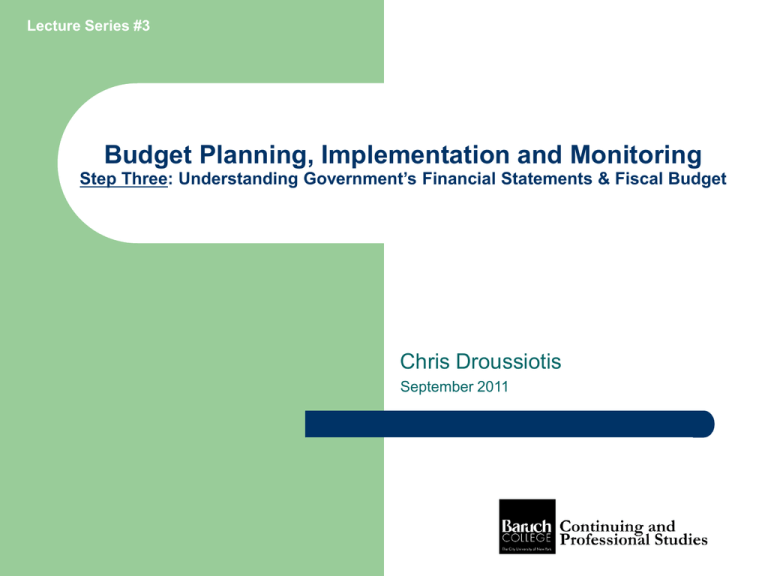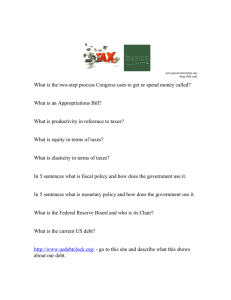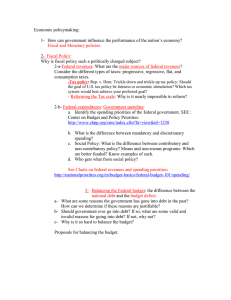Budget Planning, Implementation and Monitoring Chris Droussiotis Step Three
advertisement

Lecture Series #3 Budget Planning, Implementation and Monitoring Step Three: Understanding Government’s Financial Statements & Fiscal Budget Chris Droussiotis September 2011 Table of Contents Corporate Vs Government Planning An Overview of Government / Public / Federal Budgeting Constitution Economics Public Finance – Managing Debt These slides could be obtain via the Instructor’s Web page at www.celeritymoment.com 2 Corporate Vs Government “Profit & Loss” 3 Profit Not for Profit Net Income/(Loss) Surplus / Deficit Exceeding Budget Meeting Budget Corporate Taxation Investment Taxation What is the Federal Budget A plan for how the Government spends your money. A plan for how the Government pays for its activities. How much revenue does it raise through different kinds of taxes A plan for how the Government manages it’s Debt obligations 4 What is the Federal Budget 5 What is the Federal Budget 6 What is the Federal Budget 7 Government’s Goal: Balance Budget REVENUE Less EXPENSES Surplus Pay Down Debt Deficit Borrow more Debt Balance Budget Approach 8 Government Revenues Government Revenues • Individual Income Taxes • Corporate Income Taxes • Social Insurance Payroll Taxes • Social Security Taxes • Medicare Taxes • Unemployment Insurance Taxes • Federal employee retirement payments • Excise taxes – taxes on alcohol, tobacco, transportation fuels and telephone services • Miscellaneous Revenues including Estate and Gift Taxes, Customs Duties, Fines, penalties 9 Government Expenses Government Spending Mandatory Spending Discretionary Spending • Social Security • National Defense • Medicare (elderly and disabled) • International Affairs • Medicaid (poor) • Technology, Space, Science • Other Mandatory • Energy • Food Stamps • Natural Resources & Environment • Supplement Security Income • Agriculture • Child Nutrition • Commerce and Housing • Veterans’ Pensions • Transportation • Education, Training and Social Services Interest Payment 10 • General Government Tracking Performance of the Budget Vs Economy 11 Tracking Performance of the Budget Vs Economy 12 Tracking Performance of the Budget Vs Economy 13 EBITDA Assessing Government’s performance Coverage Ratio = The First performance measurement Projecting Expenses – Mandatory Adjusting Expenses – Discretionary View on the Economy and Outlook Achieving desired Growth To Increase Tax or not to Tax Incentives on Investments / businesses / lending Debt Management (Payment / Borrow) 14 Assessing Government’s performance The Relationship of Surplus and Debt = The Second performance measurement 15 Assessing Government’s performance The Relationship of Surplus and Debt = The Second performance measurement Capital markets • Coupon Vs Yield (secondary) • Maturity (short Vs long) Other Concepts: • Quantitative Easing (QE1 & 2) 16







